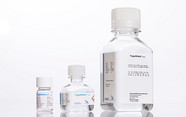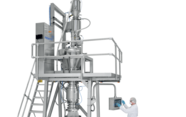AI Approach to Transdermal GLP-1s
How do you design, refine, and optimize novel GLP-1 drugs that could improve patient experiences? With a computer, of course.
| 3 min read | Interview

Traditional drug discovery often relies on high-throughput screening and iterative lab-based modifications. ImmunoPrecise Antibodies (IPA) is taking a different path by using a computational platform to design, refine, and optimize GLP-1-like sequences. By analyzing conserved evolutionary patterns and structural motifs, their AI-driven approach aims to predict optimal sequence and structural characteristics in silico, enhancing stability, improving receptor engagement, and optimizing pharmacokinetics. The goal? To develop GLP-1 therapies that are longer-lasting, more effective, and potentially easier to administer with fewer side effects.
In this Q&A, IPA CEO Jennifer Bath explains how AI-designed GLP-1 therapeutics using a transdermal approach could overcome some of the challenges of current treatments.
How do AI-designed therapies address common challenges associated with current GLP-1 treatments?
Traditional GLP-1 therapies degrade quickly because of enzymatic breakdown by the enzyme dipeptidyl peptidase-4 (DPP-4), requiring frequent injections. AI-designed sequences can incorporate predicted structural modifications that may enhance resistance to degradation, improve binding affinity, and extend half-life without relying on chemical modifications or external stabilizers. By selecting a construct carrying the sequence that may be well suited for alternative delivery methods, including potentially transdermal delivery with sustained, controlled release, the aim is to reduce the need for frequent administration.
Why could a transdermal approach be so beneficial for GLP-1s?
Transdermal delivery offers a non-invasive alternative to injections, which could improve patient compliance and eliminate injection-related discomfort. Sustained absorption through the skin could ensure a steady plasma concentration, which could reduce fluctuations in drug levels, leading to more consistent therapeutic effects. Additionally, the use of targeted technology for optimized gene expression may support long-term drug production, further enhancing the feasibility of a low-frequency dosing regimen.
What are the scientific and technical challenges of delivering GLP-s transdermally? How is the company approaching these?
Because the skin is a natural shield, it can be hard for biologic/large molecule drugs to pass through, which is why transdermal delivery is rare. Specific to GLP-1 drugs is that they break down easily from skin enzymes and body processes, losing effectiveness, plus storing them at room temperature is difficult. This creates another challenge in that patches need to release medicine slowly over days while delivering enough to work. One approach will be to focus on molecular redesign using advanced engineering to create smaller, more stable versions of GLP-1 tailored for skin absorption, creating delivery enhancements that will combine skin-friendly formats (e.g. patches or gels) with methods to improve drug penetration. We also plan to explore gene-based platforms to enable the body to produce therapeutic molecules internally, reducing dosing frequency.
How does IPA plan to collaborate with other stakeholders to integrate these therapies into existing diabetes treatment protocols?
IPA is working with Aldevron to produce the constructs that can deliver the therapy. We’re also exploring collaborations with pharmaceutical companies and research institutions to align AI-discovered therapeutics with current treatment standards. By integrating potential stakeholder insights early in the development process, the aim is to ensure seamless adoption within existing diabetes and metabolic disease management protocols.
In light of recent studies highlighting both the benefits and risks of GLP-1 medications, how are AI-designed therapies being optimized to maximize benefits while minimizing potential adverse effects?
Targeted sequence design could improve binding specificity to the GLP-1 receptor while minimizing off-target effects. The platform includes a proprietary immunogenicity screening module which helps predict and mitigate potential immune responses, reducing the risk of unintended immunogenicity and side effects in therapeutic candidates. By computationally assessing T-cell epitope mapping and antigenicity, I believe GLP-1 constructs have been refined for optimal immune tolerance while maintaining therapeutic efficacy.
Additionally, the gradual, controlled release of transdermal formulations may mitigate peaks and troughs in drug levels, leading to a more predictable therapeutic response and reducing common side effects such as gastrointestinal distress, nausea, or excessive appetite suppression.
If you had unlimited research funds available, what would be the next phase in this research?
With unlimited resources, I would accelerate in vivo validation of AI-designed GLP-1 constructs, focusing on optimizing transdermal delivery mechanisms and long-term metabolic effects. Additional efforts would include exploring synergies with other incretin hormones (such as GIP and glucagon) to create multi-functional metabolic therapies, as well as investigating how AI-driven biologics can be applied beyond metabolic diseases, including aging and longevity research.



















